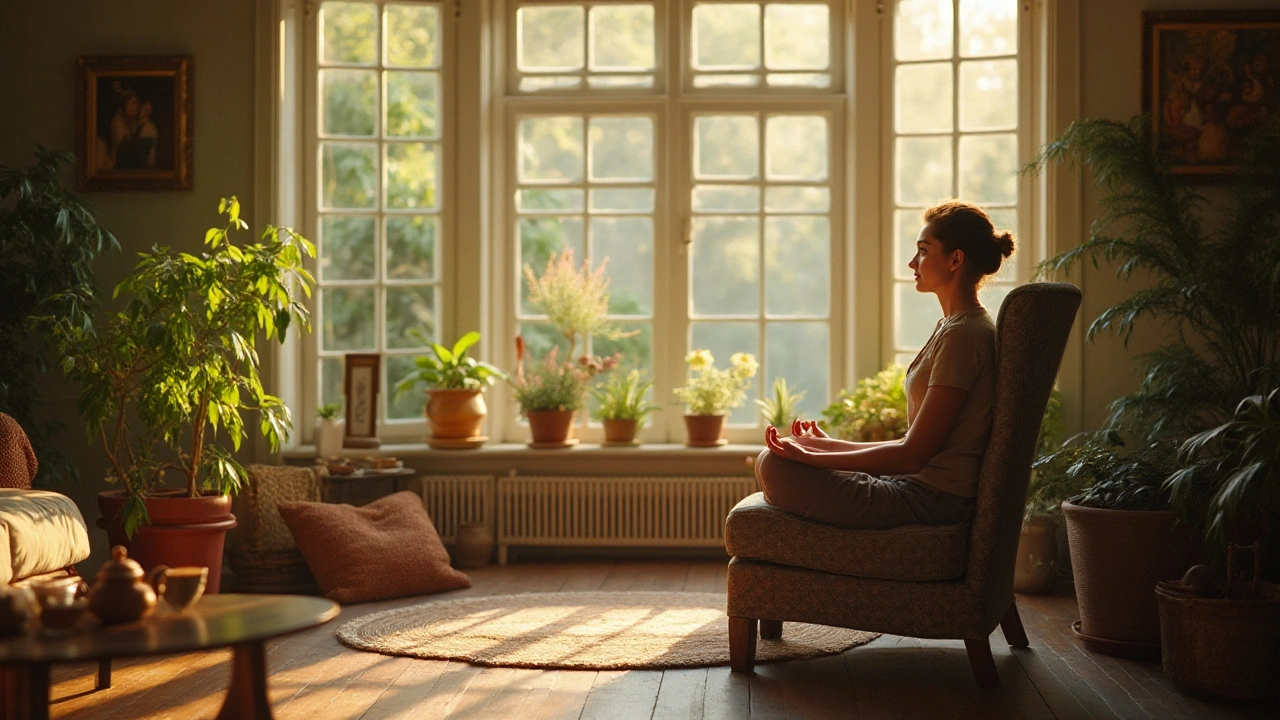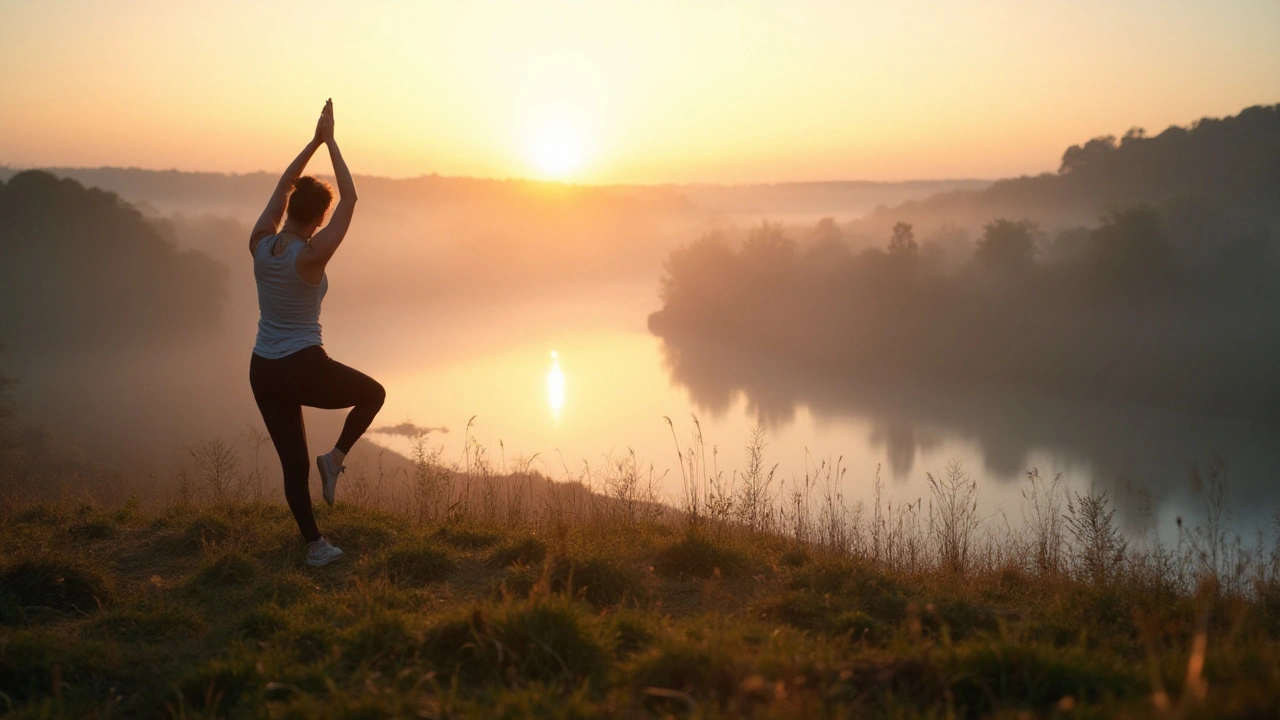In a world where every second seems to scream for attention, finding moments of peace can feel like trying to catch a breeze in your hand. But did you know that relaxation is not just a luxury? It's essential to our well-being. Today, we explore some of the most effective methods to cultivate tranquility in our fast-paced lives.
Delve into breathing exercises that can transform stress into peace with just a few, focused inhales and exhales. Learn why mindfulness and meditation are more than just buzzwords, but tools that can anchor you amidst the chaos. Explore how physical movements can seamlessly tie into your calmness quest, and why creating a routine could be your best ally.
Join this journey and unlock methods not just to escape the stress but to build a life where peace is a natural state.
- Introduction to Relaxation Techniques
- The Science Behind Calm
- Practical Breathing Exercises
- Mindfulness and Meditation
- The Role of Physical Activity
- Creating a Relaxation Routine
Introduction to Relaxation Techniques
Relaxation, a deceptively simple word, holds layers of meaning in our bustling modern lives. In today’s era of constant notifications and perpetual to-do lists, the art of unwinding is paramount. Understanding relaxation techniques can essentially serve as a lifeline in maintaining mental well-being. Historically, humans have always sought ways to alleviate stress, whether through communal rituals or individual practices. As we evolved, so did these techniques, adapting to the era's demands and technological advances.
There's an intriguing science behind what we know as calming practices. They work on both mental and physical spectrums by engaging the body's relaxation response—a state of deep rest altering the physical and emotional responses to stress. Harvard Medical School's Dr. Herbert Benson coined this term, highlighting its benefits that include decreased metabolism, lowered blood pressure, and slower breathing. Such practices can counterbalance our body's stress reaction, helping to prevent diseases exacerbated by stress.
Imagine sipping on a warm cup of tea as a blanket of serenity wraps around you. That's what effective relaxation techniques aim to replicate, both instantly and in the long term. Some popular methods include meditation, yoga, deep breathing exercises, and more recently, biofeedback. Tapping into the resources at our disposal is akin to opening a treasure chest of tranquility. Incorporating these into daily routines isn't indulgent but a necessary step toward holistic self-care.
"Adopting the right attitude can convert a negative stress into a positive one," Hans Selye famously mentioned, emphasizing the transformative power of our approach to stress management.
An encouraging aspect is the diversity of methods available, making it accessible for anyone to find their groove. Let's not forget the scientific backing that assures us of these techniques' effectiveness. For instance, consistency in practice significantly bolsters their impact. Studies show that integrating mindful habits just for a few weeks can lead to measurable changes in the brain, enhancing areas related to perception, body awareness, pain tolerance, emotion regulation, introspection, complex thinking, and sense of self.
To tap into the full potential of these practices, consider tailoring them into personalized sessions. Break away from the 'one size fits all' notion; instead, celebrate the unique paths that lead to individual peace. Recognize when you're most receptive to relaxation, whether at sunrise, post-lunch, or moonlit nights, and mold your practice around that. This tailoring cements relaxation as part of your life, ensuring that these techniques are more than just fleeting sensations but lasting lifestyle changes. The journey to stress relief and achieving genuine inner peace is personal yet universal, bringing together threads of shared experiences through unique paths.
In the echoes of today's fast-moving world, relaxation techniques offer a captivating lullaby that soothes and empowers. Diving into relaxation might initially seem like merely pressing pause, but with diligence, it transforms pauses into opportunities for growth and renewed energy. These rhythmic interludes can become the cadence that carries us through the chaos, grounding our minds and nurturing our souls for the harmonious living we all aspire to achieve.
The Science Behind Calm
Understanding the science behind calm is a fascinating exploration into how our body and mind respond to various relaxation techniques. Stress, as we know it, triggers a cascade of reactions in the body, involving a surge of hormones like adrenaline and cortisol, which prepare us for the 'fight or flight' response. But what happens when we take a moment to breathe deeply, meditate, or enjoy a leisurely walk? Each of these actions can significantly alter the body's chemistry. When we engage in deep, intentional breathing, it signals the brain to calm down and relax. This triggers the parasympathetic nervous system, often referred to as the "rest and digest system," which helps decrease the heart rate and blood pressure, bringing the body back to a state of equilibrium.
It's interesting how small actions can lead to such a profound change. Research has shown that regular practice of mindfulness and meditation not only impacts our emotional health but also rewires the brain. According to neuroscientists, repeated practice enhances areas of the brain responsible for regulating emotions and reducing fear. These changes don't just improve mental well-being in the short term. They can foster long-term resilience against stress. "Mindfulness activates regions of the brain responsible for more adaptive responses to stress," says Dr. Sara Lazar from Harvard Medical School. "Over time, this can lead to a decrease in overall stress levels."
Besides psychological benefits, there's growing evidence of the positive impact on physical health. Studies reveal that practicing relaxation techniques consistently can improve sleep, reduce pain, and even boost the immune system. Imagine, a few minutes dedicated to relaxation each day, aiding the body in fighting off infections and diseases. To illustrate the impact, a study published in 'Health Psychology' found that participants who engaged in regular meditation showed higher levels of antibodies, which are crucial for immune function, compared to those who did not.
Each technique, whether it's mindfulness, deep breathing, or physical activity, works its magic by tapping into the body's innate capability to restore balance. This science-backed understanding reveals why integrating such habits into our daily routine isn't just wise—it's transformative. Consider developing a personal relaxation routine to harness these benefits efficiently, leading to a healthier, calmer you in 2025 and beyond.

Practical Breathing Exercises
There's a certain power in the simple act of breathing, one that is often overlooked in our quest for tranquility. Slow, deliberate breathing can do wonders for our stress relief, unlocking a sense of calm we never knew was possible. Consider diaphragmatic breathing, where the focus is on drawing deep breaths into the belly rather than shallow inhales into the chest. This shift can trigger the body's relaxation response, reducing heart rate and blood pressure. To practice, sit or lie comfortably, place one hand on your chest, and the other on your belly. Inhale through your nose slowly, letting your belly push your hand up. Exhale gently, feeling the belly fall as you do. It's a simple exercise, yet repeated practice can transform stress patterns.
Alternate nostril breathing is another useful technique. It's rooted in yogic traditions and balances the body's energy levels. To practice, close one nostril with your thumb, inhale through the open nostril, then switch nostrils gently using your fingers to exhale. Repeating this pattern can help in balancing your mind and often delivers instant results in terms of calming the nerves. Scientific studies have begun to show the benefits of these practices, showing measurable drops in stress hormones and improvements in mental focus.
Breath Counting as a Mindfulness Tool
Another breathing technique, which may not be as well-known but is equally effective, is breath counting. It centers the mind and helps develop a meditative focus. Start by sitting in a comfortable position, keeping your spine straight. Inhale deeply and as you exhale, count "one." With the next exhale, count "two," continuing up to five. Then start again at one. The key here is staying focused on your breath and the count, quietly guiding your mind away from the distracting thoughts. According to studies by Harvard Health, incorporating such mindful breathing into our daily routine can significantly boost our mental well-being.
"Calm mind brings inner strength and self-confidence, so that's very important for good health." — Dalai LamaFor those looking to dive deeper, pairing breathing with visualization can enhance the experience. Imagine as you exhale, that you're releasing tension out of your body like a cloud of smoke. This mental imagery combined with controlled breathing creates a powerful synergy that candidates frequently use to quash anxiety before speeches or presentations. Remember, the true magic of breathing practices lies in their accessibility. Any moment of stress, whether you're stuck in traffic or before bedtime, can be softened and dissolved by taking a few conscious breaths. Start today, and gradually allow your breath to transform your daily experiences.
Mindfulness and Meditation
In the pursuit of inner peace, mindfulness and meditation often stand out as indispensable tools. These practices have mingled with human history, deeply rooted in cultures ranging from ancient Eastern philosophies to modern Western lifestyles. Mindfulness is about achieving a state of active, open attention on the present. Rather than letting your life pass you by, it means living in the moment and awakening to your current experience. Meditation, on the other hand, is the practice of training your mind or inducing a mode of consciousness to realize some benefit, be it the reduction of stress or the enhancement of happiness.
The science behind mindfulness is compelling. Numerous studies have shown that engaging consistently in mindfulness practices can significantly reduce symptoms of anxiety and depression. The American Psychological Association highlights that mindfulness improves emotional regulation and increases cognitive flexibility. UCLA neuroscientist Dr. Eileen Luders found that meditators have stronger connections between brain regions. These benefits extend to our bodies too, with improved biomarkers of health like blood pressure and immune response.
"Mindfulness isn't difficult, we just need to remember to do it," says Sharon Salzberg, a leading figure in the field of meditation, emphasizing its accessibility and simplicity.
To practice mindfulness, one can start by setting aside a few minutes each day to focus solely on breathing, sitting quietly while observing thoughts passing through the mind without engagement. Meditation, such as loving-kindness or body-scan, can help tap into deeper consciousness. Google Search trends reveal an increasing interest in mindfulness apps and online meditation courses, indicating a shift in how individuals seek stress relief. These digital aids keep people guided, especially those new to the practice. Headspace and Calm are popular apps that offer hundreds of guided meditations tailored to various aspects of life, like sleep, focus, or motivation.
The benefit landscape of mindfulness and meditation isn't just limited to mental health. Studies suggest they enhance problem-solving skills and creativity. A report by the University of Washington stated that those who meditated regularly performed better in multitasking tests, displaying superior focus and efficiency. For those looking to dive into these practices, it's often recommended to start with guided sessions via apps or local groups to establish a routine that grows into daily habits. Remember, integrating these practices into daily life is akin to planting seeds for a peaceful state of mind, which nurtures and yields a garden of seasonal serenity.

The Role of Physical Activity
Engaging in physical activities is often overlooked as a straightforward path to discovering our inner calm. Yet, movement is inherently tied to our mental well-being and stress relief. Our bodies are designed to move, and when they do, endorphins, often called the body’s self-generated 'feel-good' chemicals, flood our system, transforming our mood almost instantaneously. From taking a brisk walk through a sunlit park to finding rhythm in a dance class, each movement has the power to shift our state of mind from chaos to calm.
There’s scientific backing to the benefits of physical activity. A study published in the American Psychosomatic Society journal found that consistent physical exercise can significantly decrease levels of anxiety and depression. The research pointed out that even modest levels of activity, such as 30 minutes of brisk walking a day, could yield considerable improvements in mental health. For many, the challenge is starting and making movement part of daily life. It’s something that can begin with small steps – quite literally – and evolve to more structured routines as the practice becomes a natural extension of living.
"Movement is a medicine for creating change in a person's physical, emotional, and mental states," noted Carol Welch, a renowned health author and coach.Creating a workout regimen doesn’t mean you need to confine yourself to a gym; instead, mix things up. Consider the joys of outdoor activities like hiking or cycling, or the meditative motions of yoga. Activities such as tai chi are perfect examples of exercise that combine physical movement with a focus on inner peace. Structured workouts can be broken down into simple segments, making them accessible and flexible around your everyday life.
The role of exercise in relaxation techniques spans beyond the obvious physical to the deeply psychological. When you engage your body, you also engage your mind, creating a double-edged approach that can whisk stress away. As the body becomes stronger and healthier, so too does the mind, fostering resilience against the mental battles tied to stress and anxiety. It’s crucial to acknowledge that each person is unique, so experimenting with different activities to find what resonates is part of the adventure towards inner peace. The journey can start slowly, but with consistency, the rewards become evident in both physical vitality and mental clarity.
Creating a Relaxation Routine
Crafting a dedicated relaxation routine can be a transformative commitment towards achieving and maintaining inner peace. The art lies in understanding that to escape the dreams of busyness, we must consciously carve out time for calm. It starts by recognizing the triggers of everyday stress. By pinpointing those constant sources of tension, you can strategically incorporate moments of peace into the day. Just like the body craves nutritious food, the mind demands its moments of stillness, an oasis amidst the desert of demands.
A practical starting point is to schedule relaxation sessions just like any other important meeting. These sessions should not be seen as indulgent but as essential pillars that support mental and physical well-being. An effective method consists of short bursts of relaxation techniques interspersed throughout the day. For instance, take fifteen-minute breaks to practice deep breathing or engage in a simple mindfulness exercise, which can rejuvenate your senses and reset your focus.
Emphasizing the importance of routine, psychologist Dr. Herbert Benson identified the practice of these stress relief techniques with his work on the





